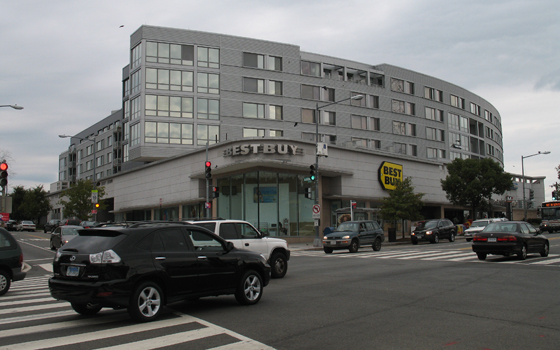Most residents and visitors admire the sleek moderne building that now houses a Best Buy and a Container Store. It is a registered landmark, ably capped by a Shalom Baranes-designed condominium. Critics and writers have shown almost nothing but praise for the structure, including Roger Lewis.
But in 1940, when Sears Roebuck first proposed the store, the neighborhood condemned the proposal and tried to stop Sears with all the weapons they had. Letters were written to Eleanor Roosevelt, lawsuits were filed, and many cried out for someone to think of the children. The primary concerns revolved around the Janney School, just as they have with the Library PPP and also in another dispute in 1991 about a homeless shelter.
Beginning in 1933 or so, Sears began to expand from the mail-order business and compete directly with established downtown department stores. Unlike Hecht’s and Woolworth’s, Sears capitalized on the growing popularity of the automobile and built their stores around the personal car. They constructed one other store in DC, on Blagdensburg Road, but here, the architects, John Stokes Redden and John G. Rabern, really catered to the desires of the motoring middle class. Based on work of Victor Gruen, who would later go on to design the first shopping mall and also the first festival marketplace, the driver enters the store in her Packard, driving up a ramp to the roof parking lot. After parking, she has to walk only a short distance to the escalators which take her down into the store below, most of the work being done by machines.
The design has benefits over surface parking. The parking takes up relatively little space and lets architects address the bustle of the street. But the introduction of those hundreds of automobiles that the store would bring worried parents at Janney, which sits across Albemarle Street. After all, the peak shopping time was around noon, when students would walk home for lunch. Parents even expressed fears that the new traffic would necessitate the closure of Janney.
There were other issues, as well. Part of the store might have sat on residential zoning, but the law was unclear. Some people worried that the store would deprecate property values. There also may not have been enough parking, only half of what the Bladensburg Road store offered. Some neighborhood residents argued that cars would park on side streets or queue to get into the garage, clogging the streets. Interestingly, the only notable change in design before groundbreaking later that year was the addition of underground parking.
Tenleytown and DC were both considerably different places then. Only twenty years earlier, Tenleytown was geographically distinct from the rest of the city, surrounded by fields. Even in 1940, the neighborhood felt like a small town. The city government was different too, unelected and cool. The zoning commissioners openly stated their contempt for community concerns in public meetings and Sears questioned the constitutionality of zoning when called to court for a lawsuit. The current zoning system is far more sympathetic to community interests and also more flexible for developers. For example, the mere concept of a PUD was unthinkable 70 years ago.
Irrespective of these differences, the cataclysms predicted by neighbors never occurred. The store helped justify the placement of the Metro stop at this location in the 1960s. Its creation was seen as drastically changing the character of the neighborhood, but in retrospect, not for the worse. That change was not all for the worse; the store and the newer density atop it have become real community assets due to their good design and appropriate scale. But history repeats itself.

The Sears store (formerly Hollywood Video) that is there now, next to the Whole Foods, is an inefficient use of retail space directly next to the metro station. Like the several mattress stores in the neighborhood, nobody is going to purchase a large appliance and then take the metro back home.
Not true. People who purchase large appliances and mattresses very often have them delivered, the ordinary passenger car not being well suited to transporting such things, so going to the store by metro can be perfectly reasonable. I’ve done it for all of our mattresses except one, where I walked to the store, and for several of our major appliances.
I’m not exactly sure why you aren’t complaining about the parking garage above the Sears outlet… or the empty storefront next door. Neither are particularly great for the area.
Blagdensburg Road?
It seems that you have intermingled “Blagden Alley” into “Bladensburg Road”, the correct location of the other in-town Sears store. Also, I know this isn’t a post on the history of Sears, but any idea when the the third Sears in DC was built, on Naylor Road?
You are right. Shows what I know about Northeast!
I do not know when the Naylor Road store opened. I really only have info from 1940-41 and some retrospective commentary after landmarking and re-use.